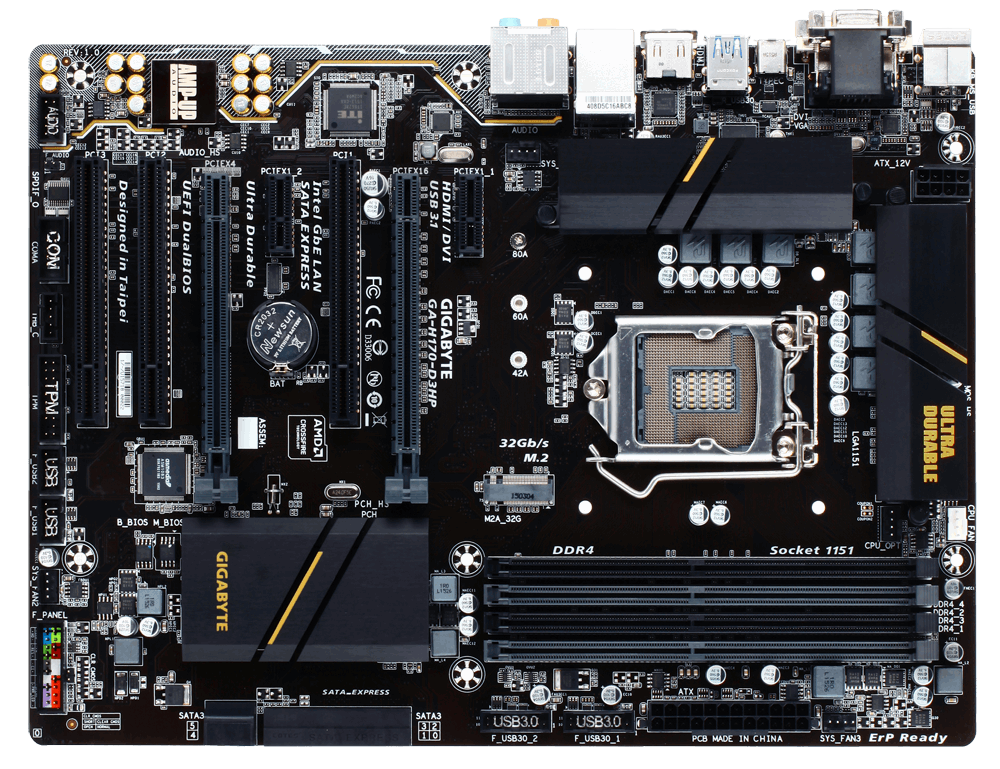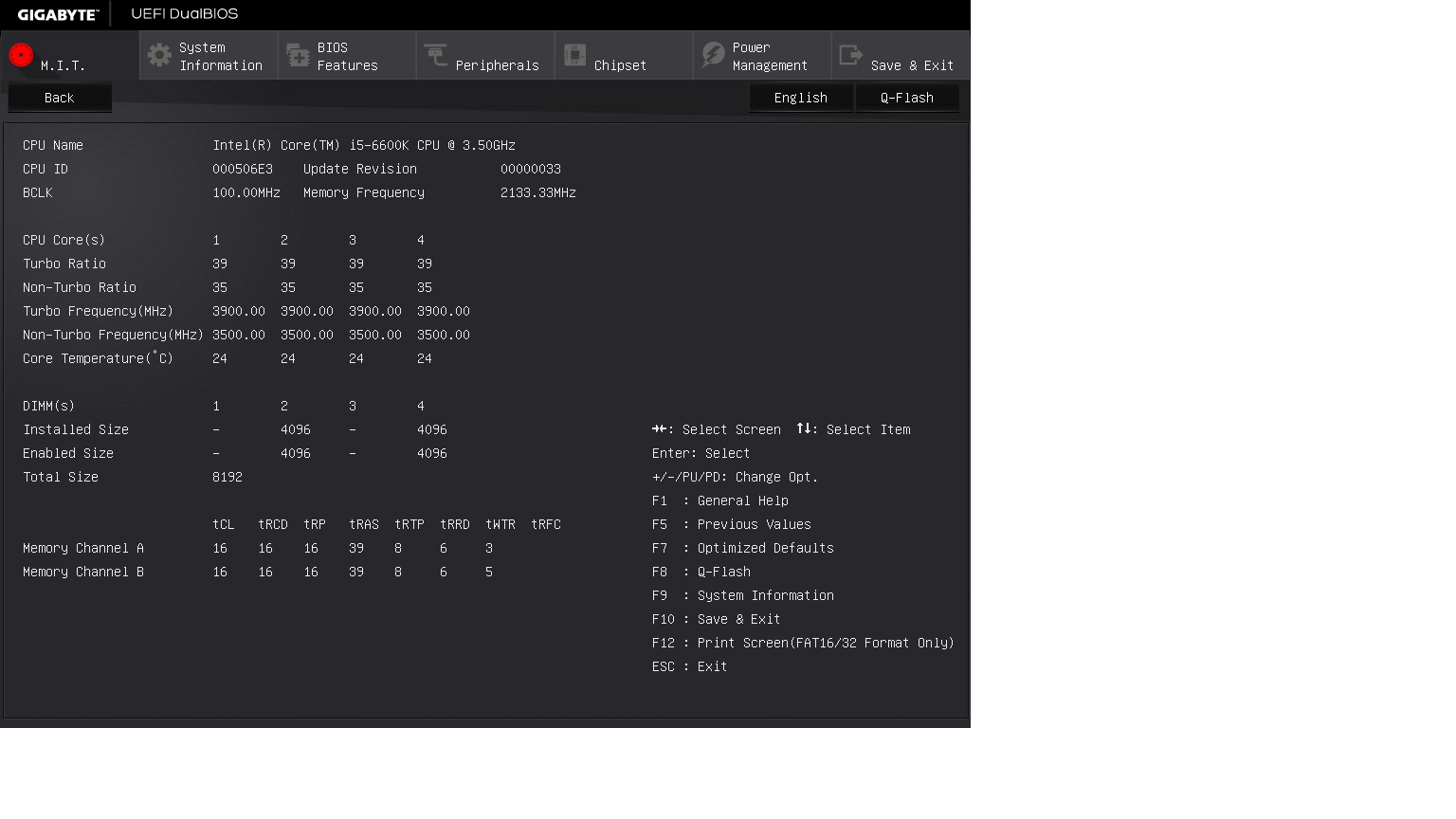ASRock, Biostar, Gigabyte, MSI H170 Motherboard Round-Up
Why you can trust Tom's Hardware
Gigabyte GA-H170-D3HP
Gigabyte's GA-H170-D3HP is another ATX board with plenty of open space and easy access to a variety of connectors. It is the only board in this round-up with a USB 3.1 Type-C connector on it. Gigabyte says that its USB 3.1 controller gets a pair of PCIe Gen3 lanes, giving it up to 16Gb/s throughput, compared to 10Gb/s throughput if a pair of Gen2 lanes are used. The onboard M.2 connector is compatible with both SATA and PCIe connectivity. This board supports DDR4 only.



In the box, you get the board, a driver CD, a pair of SATA cables, an I/O backplate and a rather thin 8-1/4-inch x 5-1/2-inch staple-bound manual. It is so thin because it is English-only. As a result, it can be coerced to lie relatively flat. You also get a "G-connector," which accepts all of your front-panel jumpers and then allows them to be plugged en masse into their pin headers. Unlike Asus' similar Q-connector, it makes no electrical connection from the pins to their headers, but instead holds them all in the correct position to be directly attached. It is definitely convenient.
The audio codec is a Realtek ALC1150, by far the best in this round-up. It has up to 115dB S/N on its output and, if I'm reading the data sheet correctly, 110dB S/N on the input. This is pro-quality, so despite this board's large size, these showings would otherwise make it a nice choice for HTPC use or other audio work.
Although there are no display or diagnostic LEDs on the H170-D3HP, the audio circuitry is surrounded by LEDs, which can be set to a number of modes, including steady, pulsing, or beating to whatever music or other audio is playing.
Gigabyte's BIOS is crisp and clean, seen on this main screen and the status screen:


There were no functional options to overclock the i5-6600K on this board, just as on the other examples in this round-up.
The layout is open, and nothing is occluded, with the possible exception of the battery, but only if the second PCIe x1 slot is used. The SATA Express and SATA 6Gb/s ports are on the front edge to the left, facing forward, so even the longest graphics card(s) will not interfere with them. The eight-pin CPU power connector is on the right edge just behind the VRM heat sink there, but the latch faces rear so there's plenty of finger room. So far, this is the only motherboard I have seen with two USB3.0 connectors. They are side by side to the left of the ATX power connector on the front edge. These connectors, as well as all other connectors along the left edge (audio, com, thunderbolt, TPM and USB2.0) are box-style, which is more secure. The fan headers are not; it is worth noting that although they are all four-pin, only the CPU fan header supports a PWM fan. All others have a different pinout, with the sense wire in the location needed by three-pin fans.
Get Tom's Hardware's best news and in-depth reviews, straight to your inbox.
The front-panel connector, in the front left corner, is not only color coded, but also comes with that "G-connector," which allows all front-panel leads to be pre-positioned, then attached all at once. I prefer this to the Asus "Q-connector," because this method does not introduce an additional point where the leads (typically all of them at once) can be accidentally disconnected.
OK, time for the numbers. Many are typical, but a few stand out. Let's take a look at the test results.
Current page: Gigabyte GA-H170-D3HP
Prev Page MSI H170I PRO AC Next Page Test Settings, Results And Final Analysis-
SpAwNtoHell 1. Valid for who upgrades their system from older platform and have already win 8.1 bought not relevant for who upgrades to win 10 or buying a new win10...Reply
2. H170 supposed to be cheaper is not entirely true... So myself i do not see the point paying for a cut chipset not less or almost no difference compared to z170... As this is inteded for budget build... -
Onus Thanks to Kasia for some quick fixes in the text.Reply
Otherwise, I take full blame (or credit) for the results! These are decent boards for most people. -
Snipergod87 Do people buy BioStar products? I have never seen them used in PCPartPicker builds or really recommended on the forums.Reply
Also I don't see why a lack of SATA-Express is a problem on the ASRock board as there are no devices to utilize it. -
turkey3_scratch Reply17750886 said:Do people buy BioStar products? I have never seen them used in PCPartPicker builds or really recommended on the forums.
Also I don't see why a lack of SATA-Express is a problem on the ASRock board as there are no devices to utilize it.
Not really, they're considered to be not as reliable, just like EVGA boards. Though there is no factual data I can think of to back up this claim, it is general consensus. -
Onus Reply
Exactly. I think they're still recovering from some bad S775 and AM2 boards they put out (I got some myself) some years ago. Their latest boards that I've seen have used the same quality caps and chokes as the Big Boys, and the boards are similarly well-made and don't feel cheap. A few minor BIOS glitches don't explain it; ASRock has had those too, as has MSI, and ASRock has also put out some really thin boards (with otherwise decent components), but they've had no serious call-outs for it. Biostar probably needs to determine whether or not their marketing and sales droids have been doing their jobs.17750935 said:17750886 said:Do people buy BioStar products? I have never seen them used in PCPartPicker builds or really recommended on the forums.
Also I don't see why a lack of SATA-Express is a problem on the ASRock board as there are no devices to utilize it.
Not really, they're considered to be not as reliable, just like EVGA boards. Though there is no factual data I can think of to back up this claim, it is general consensus.
-
jtd871 I'm pleased that you reviewed a H170 mITX mobo. But I don't know why you list 1) "Limited expandability due to size" and 2) "M.2 is only PCIe" as cons for the MSI board.Reply
1) People buying a mini-ITX board don't want (or expect) much, if any, expandability. Limited expandability is arguably the whole point of mITX.
2) The only compelling reason to go with an M.2 interface is to use a (PCIe x4) NVMe SSD. If the M.2 interface *wasn't* PCIe, only then it should be called out as a con. -
Onus Yes, point #1 is self-evident, but it is fair to point out, as it is a sufficient con that many people will not be able to go with a mini-ITX build. Although there are many USB3.0 peripherals available, a builder who already has a PCI video capture card, or a PCIe wireless NIC, may not wish to re-buy USB versions. I will disagree about point #2 on the basis of all the other boards' M.2 interfaces working with both card types. Someone building new would likely insist upon PCIe for the M.2 slot (as you say), but someone moving a drive, even if he plans a future upgrade, initially needs mSATA as well. To be fair, a slot that can only take a mSATA drive would also be listed as a con.Reply
As always, a given Pro or Con may not apply to you, so it might not affect your decision at all. If it does apply, it could be a dealbreaker to some.
-
80-watt Hamster Reply17750886 said:Do people buy BioStar products? I have never seen them used in PCPartPicker builds or really recommended on the forums.
Also I don't see why a lack of SATA-Express is a problem on the ASRock board as there are no devices to utilize it.
I had a Biostar 754 board back in the day. Never gave me a bit of trouble, though I didn't exactly push it particularly hard. It powered the last iteration of my Linux box (still have the drive with the /home partition, swear I'll resurrect it... someday), and was in service for probably 4-5 years. In fact, I think it's hanging out in a box destined for electronics recycling, and would probably still work if plugged back in. No time/motivation to find out, though. *sigh*
Digressions and nostalgia notwithstanding, I'd have no problem using one again. Hard to justify, though, when Biostar's availability is so spotty, and equivalent products from the majors regularly undercut them when on sale. -
RedJaron One thing the memory bandwidth benchmarks can help point out is the difference in board auto RAM timings. A lot of boards advertise they can supported OC'd RAM, but not all of them have the best performance at those speeds. I've seen plenty of Z97 boards that can run RAM at 2800 and 2933 frequencies, but they actually have poorer bandwidth than at 2666. Typically this is because the auto values for the secondary and tertiary timings are set very loose to make it easier to run the RAM modules at higher speeds. The RAM is stable, but it's not performing as quick as it could.Reply -
jlake3 This isn't unique to these boards, but does anyone know why so many boards are still including PCI slots? While they're nice in certain cases for backwards compatibility, I feel like they shouldn't be quite as prolific as they still seem to be.Reply
In an ATX board it's not a huge problem unless you're running a particularly large number of expansion cards, but on an mATX board like the Biostar this roundup it gets a little constraining.